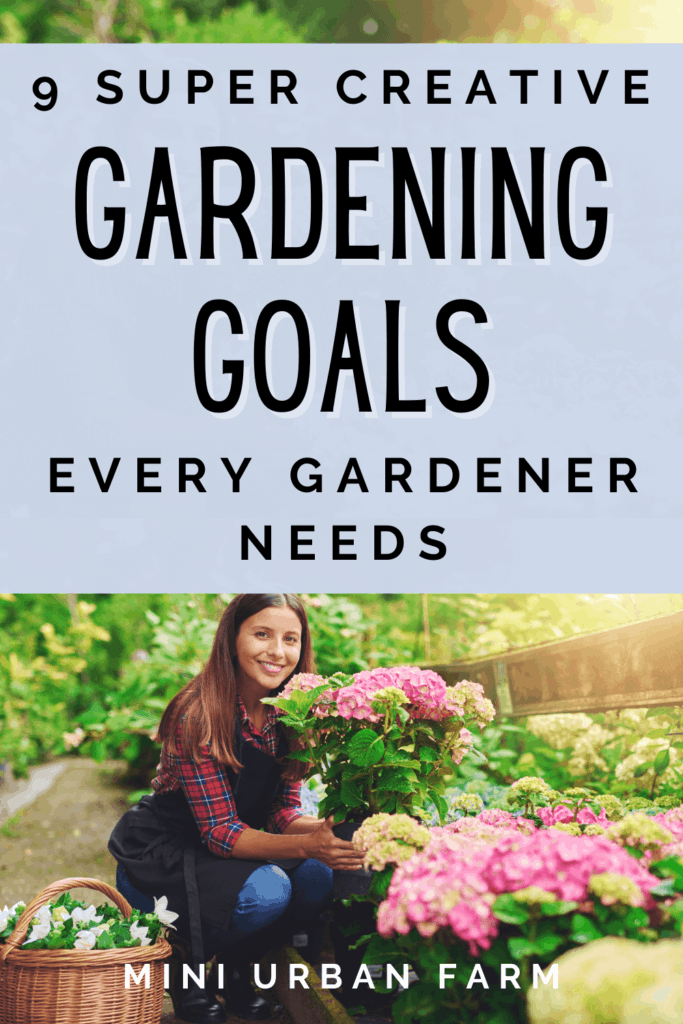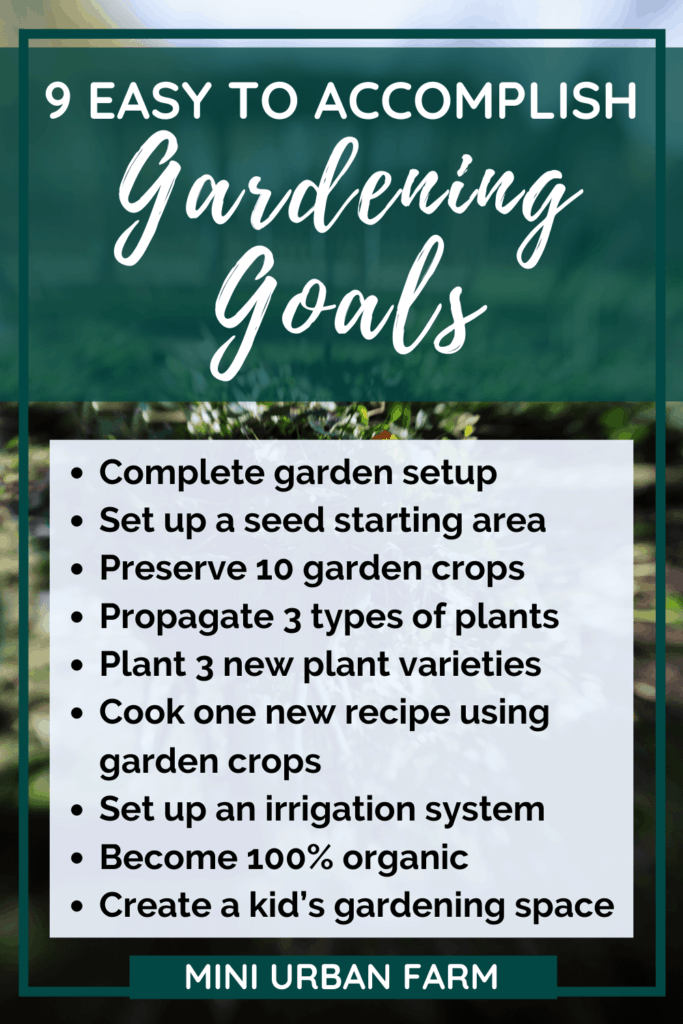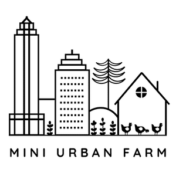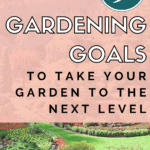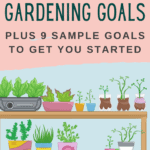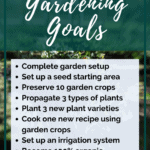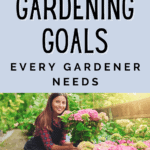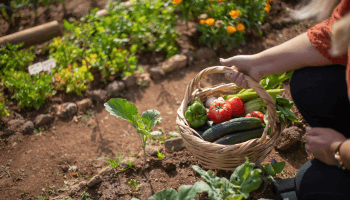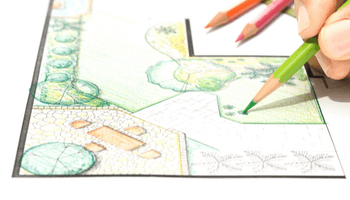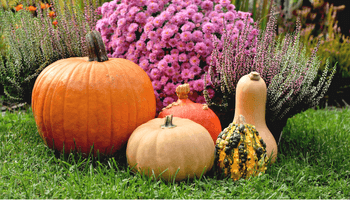Gardening can be an amazing hobby. But if you’re serious about gardening and growing your own food, then you should consider setting some gardening goals to help you make the most of your garden! In this article, I’ve outlined some of my own gardening goals I’ve made through the years and help you set your own as well!
Gardening Goals Every Gardener Needs:
- Complete garden setup
- Set up a seed starting area
- Preserve 10 garden crops
- Propagate 3 types of plants
- Plant 3 new plant varieties
- Cook one new recipe using garden crops
- Set up an irrigation system
- Become 100% organic
- Create a kid’s gardening space

Disclosure: This post may contain affiliate links. If you purchase a product through one of our affiliate links we make a small commission from the sale at no extra cost to our readers.
How to Decide on Gardening Goals
First you will need to think about where you are in your gardening journey.
- Are you a beginner gardener looking to start your garden?
- Do you have an existing garden and want to learn new skills?
- Are you an advanced gardener who is looking to grow all your own food?
Determining where you are in your journey (and where you want to go) will help you outline your goals and set a clear path for yourself.
For example, I can give you all of my gardening goals – but that might not be the same as what you hope to achieve with your garden.
Think about your own gardening objectives – why are you gardening?
Sample Gardening Objectives
There are some basic gardening objectives will remain the same for most gardens – grow plants to eat, grow ornamental plants, or grow medicinal plants.
But you can also get more specific. For example, my garden’s objective (it’s main overall goal, if you will) is to grow all of my own vegetables and herbs to eat .
But you may not be interest in this objective.
Maybe you want to grow your own tea so you can start your own tea shop. Or maybe you want to become a seed farmer and your gardening objective is to grow seeds to sell. Or one of your objectives could be to grow all your own chicken feed!
No matter what your main objective is, breaking it up into smaller, achievable goals will help you get there!
And if you’re looking for a step by step guide to help you achieve your gardening goals, check out my gardening workbook!
Gardening Goal Structure
Back in a previous life, I was a therapist. Yes, the “and how do you feel about that?” kind of therapist.
And even though I no longer practice therapy, one of the most important things I still practice is setting great goals.
I do this by setting smart goals for gardening – SMART goals stands for specific, measurable, attainable, relevant, and time-based.
For me, the two most important of those (and the ones I’ll focus on the most) are measurable and time based.
You always want to set a deadline (time-based) since a goal without an end date is really just a wish.
And you want your goals to always be measurable. So that you have a concrete way of knowing when it has been accomplished!
Let me show you – which one of these is a better goal?
- GOAL: Set up a garden to grow food
or
- GOAL: Set up a garden to grow 50% of my own vegetables by October 1st
- 1 – Decide which plants to grow based on my hardiness zone
- 2 – Map out space for garden using grid paper
- 3 – Buy seeds and gardening supplies
- 4 – Build raised beds and fill with soil
- 5 – Direct sow seeds into garden
Hopefully you agree that the second goal will probably be more successful!
Why? Because it has a deadline and exact steps to get you there! Plus it has a way to measure it’s completion.
So in the example goals below, I’m not going to give you some wishy-washy goals that you don’t know how to implement. I’ve outlined real goals and real steps I’ve taken to set and accomplish these gardening goals.
So just change the dates and you’re good to go!
1) Complete garden set up by the beginning of March
This goal is for beginner gardeners and anyone who wants to create a new gardening space.
In fact, when I first moved in with Mr.Mini Urban Farm, this was one of the first gardening goals I made because he didn’t have an existing garden.
In order to achieve this goal, you will need to decide a few things first.
For example, where will the garden go? How much space will you allocate to the garden? What type of garden do you want to plant?
These things will then determine the steps you add to your goal.
In my case, I had approximately 450 to allocate to my garden on the side of the house. And I knew I wanted to plant a combination of vegetables, herbs, and some flowers. But the main objective of the garden was to grow food.
So some of the steps for this goal were:
- Map out the physical garden space and get rid of the plants and grass
- Finalize your garden layout with raised beds and pots
- Decide what to plant for the season & buy seeds
- Build the raised beds and fill with soil
- Build trellises on the raised beds – you can watch how I make my trellises here.
- Start seeds indoors for transplanting
- Direct sow seeds and transplant seedlings into the garde
2) Set up a seed starting area by August 1st
Once the garden was set up, I quickly realized I was going to need an area strictly for starting seeds and up-potting seedlings.
Because it was clear that the back patio table was not going to cut it.
So after a lot of compromise, Mr.Mini Urban Farm and I decided to allocate an area on the back patio for me to keep all my garden supplies and be able to do some gardening work.
Here are some of the steps I included in this goal:
- Decide where on the patio the seed starting area will go
- Research elements needed in a good seed starting setup
- Order supplies – this ended up being a mini greenhouse which worked out really well for seed starting
- Build potting bench with scrap wood
- Make seed starting soil from scratch – watch how I make my own here.
- Organize gardening tools and soil into seed starting area
3) Preserve 10 garden crops by the end of this year
This is one of my current gardening goals that I am still working through!
And if you grow tons of food like I do, then at some point you’ll probably want to preserve it for later use. Since there’s only so much of it that you can use in one season!
Preserving vegetables is an amazing way to prepare for the unexpected (like the pandemic), but also saves you tons of money since you can shop your own kitchen for groceries!
So far, I’ve learned to dehydrate and freeze vegetables, next up is canning!
Here are some of the steps I included in this goal:
- Learn about food preservations methods
- Decide which methods you want to use (for me it was dehydrating herbs, and freezing and canning vegetables
- Gather supplies needed
- Dehydrating herbs
- Start freezing vegetables
- Practice canning vegetables
Psst…want to fast track your garden? Get access to my FREE gardening resource library and start maximizing your garden today!
4) Propagate 3 types of plants by April 30th
A great skill that every gardener should have in their skills toolbox is propagating plants!
And it’s actually not that hard to learn how.
Propagating your own plants simply means to take cuttings off of existing plants and root them so that you can replant them and make new plants!
I use this technique especially for making new herb plants to give away as gifts and to sell. Which is a great way to garden on a budget!
Here are some steps to take for accomplishing this goal:
- Research methods for propagating plants
- Take cuttings from existing plants
- Gather supplies – seed starting pots, seed starting soil, rooting hormone
- Practice rooting in soil
- Practice rooting in water
5) Plant 3 new plant varieties every season
This is a great example of one of my ongoing gardening goals for my garden!
Every season I have my list of go-to plants which I depend on for my vegetables. And then I make it a point to add in a few new varieties – at least 3 to be specific.
Usually this includes a new tomato variety, a new type of pole bean, and a totally new vegetable crop that I’ve never planted before.
Sometimes I come across these new varieties by looking at other garden blogs and vlogs, or simply by flipping through the season’s seed catalogs!
A few that I’ve recently tried are pink podded pole beans, zebra pole beans, orange peach tomatoes, red okra, black cherry tomatoes, cucamelon, and ground cherries!
A few things to include as steps in this goal would be:
- Research new varieties of tomatoes (or beans, salad greens, etc)
- Learn about companion plants and spacing requirements
- Decide on new varieties for the upcoming season
- Order seeds
- Start seeds or direct sow
And if you lack the patience to wait for new crops like me, check out these super fast growing summer vegetables!
6) Cook one new recipe per week using garden crops
This is definitely one of my favorite goals I’ve set for myself so far since I love to cook!
And of course, one of the main benefits if growing your own food is being able to eat it!
So for the past few seasons I’ve set a goal for myself to try one new garden recipe using my fresh (or preserved) crops – either vegetables or herbs!
So far I’ve tried several new green bean recipes, perfected my homemade tomato sauce, added fresh herbs to my homemade breads, and even made shakshuka a few times with my cayenne peppers and roma tomatoes!
For this goal there aren’t as many steps, but I still include them in my gardening goal tracker:
- Research new recipes that use vegetables or herbs you’re currently growing
- Gather ingredients for recipe
- Make recipe & decide if it’s a keeper
- Add recipe to your garden recipe stash
7) Set up an irrigation system by June 1st
Setting up and irrigation system for my garden was one of the best decisions I made last season!
Instead of spending hours per week watering my garden by hand, I know that my irrigation system will go off on schedule and all I have to do is adjust as needed.
Plus, when I’m out of town I know my plants are being watered and I don’t have to ask a neighbor to help out!
Now, there were definitely some mistakes I made when setting up my system. So giving yourself extra time to research and learn about drip irrigation is essential!
Here are the steps I added to my tracker for this goal:
- Research plant watering needs for vegetables in the garden
- Learn about drip irrigation vs micro sprinklers and other irrigation sprayers
- Draw out the current garden layout
- Add in the ideal flow of tubing and emitters in your garden
- Plan out where each emitter will go
- List out all tubing, connectors, and emitters needed
- Purchase all irrigation supplies or a drip irrigation kit like this one
- Install drip irrigation in the garden
- Monitor plant growth and adjust irrigation as needed
8) Become 100% organic by next season
I have a love/hate relationship with organic gardening!
On the one hand, I love it because I know that my garden has no chemicals in it. And ultimately that’s one of the reasons I grow my own food – to avoid pesticides and other harmful chemicals in my food.
But on the other hand, organic gardening is so much more challenging that just spraying your garden to get rid of pests and disease!
And becoming 100% organic is no easy task. To be honest, I actually went cold turkey on this goal, instead of setting a SMART goal.
But if this is something you’re looking to achieve, using the steps below will help you get there – hopefully without killing all your plants like I did!
- Learn about soil health
- Research companion planting for pest control
- Learn about organic sprays and powders for pest and disease control
- Reduce non-organic methods and replace with organic methods by half
- Reduce non-organic methods and replace with organic methods by 75%
- Transition to fully organic gardening
- Document what disease and pest control methods work well for you
9) Create a kid’s gardening space
This is actually one of my future goals since I don’t have the space right now to allocate to a separate kids garden.
But if you do have kids and you have a few feet of extra space, you can add this one to your list of goals for the garden!
Teaching your kiddos about gardening and incorporating them into your gardening hobby is an amazing way to get them outside and instill healthy habits!
Plus, kids love getting their hands dirty so it probably won’t take too much convincing!
So while they think they’re just getting to play in the dirt, they’re actually learning important skills like patience, compassion, observation! Not to mention they’ll learn how to grow their own food!
Sounds like a win-win to me!
Include these steps in your kid’s gardening goals:
- Talk to your kids about setting up a gardening space for them
- Research easy to grow vegetables and plants
- Let them decide which plants they want to grow & order seeds
- Allocate a small space for the kid’s garden
- Include your kids in building a small raised bed
- Teach them about healthy soil and creepy crawlers in the garden
- Have your kids start their seeds and direct sow seeds
- Teach your kids how to water the garden
Gardening Goals Recap
Just like making a plan for your garden season will help you have a more successful season, setting goals for your garden will help you make your gardening dreams come true! Throughout the years I have always set garden goals and I am always surprised at everything I have been able to accomplish with my garden. Last season for example, we grew all of our own vegetables and herbs for the first time! So use these goals to create your own, or steal some of mine and you’ll be on your way in no time!
I hope this was super helpful! And for more gardening resources, get access to our free gardening resource library! It will help you fast track your garden and it only takes 5 seconds!
Pin Gardening Goals
